Numerical Investigation on the Ballistic Performance of Semi-Cylindrical Nacre-like Composite Shells under High-Velocity Impact
Abstract
:1. Introduction
2. Elasticity Theoretical Analysis
2.1. Problem Description
2.2. Theoretical Formula Derivation
2.3. Validation of Theoretical Results
2.4. Theoretical Parameter Analysis
3. Materials and Numerical Methods
3.1. The Generation of Nacre-like Composites
3.2. Materials Models
3.2.1. Material Model of Ceramic
3.2.2. Material Model of Aluminum (AA5083-H116)
3.2.3. Aluminum Material Model Validation
4. Resistance Characteristic Analysis
4.1. Impact Response of Semi-Cylindrical Shells
- The bullet impacts the composite outer surface, and the outer surface is concaved.
- Tablets were impacted to fragments, and some tablets fall off from the inner surface of composites.
- Tablets almost completely show failure at the impact position, and the slurry begins to deform and show failure.
- The slurry shows failure completely and the composites are penetrated by bullets.
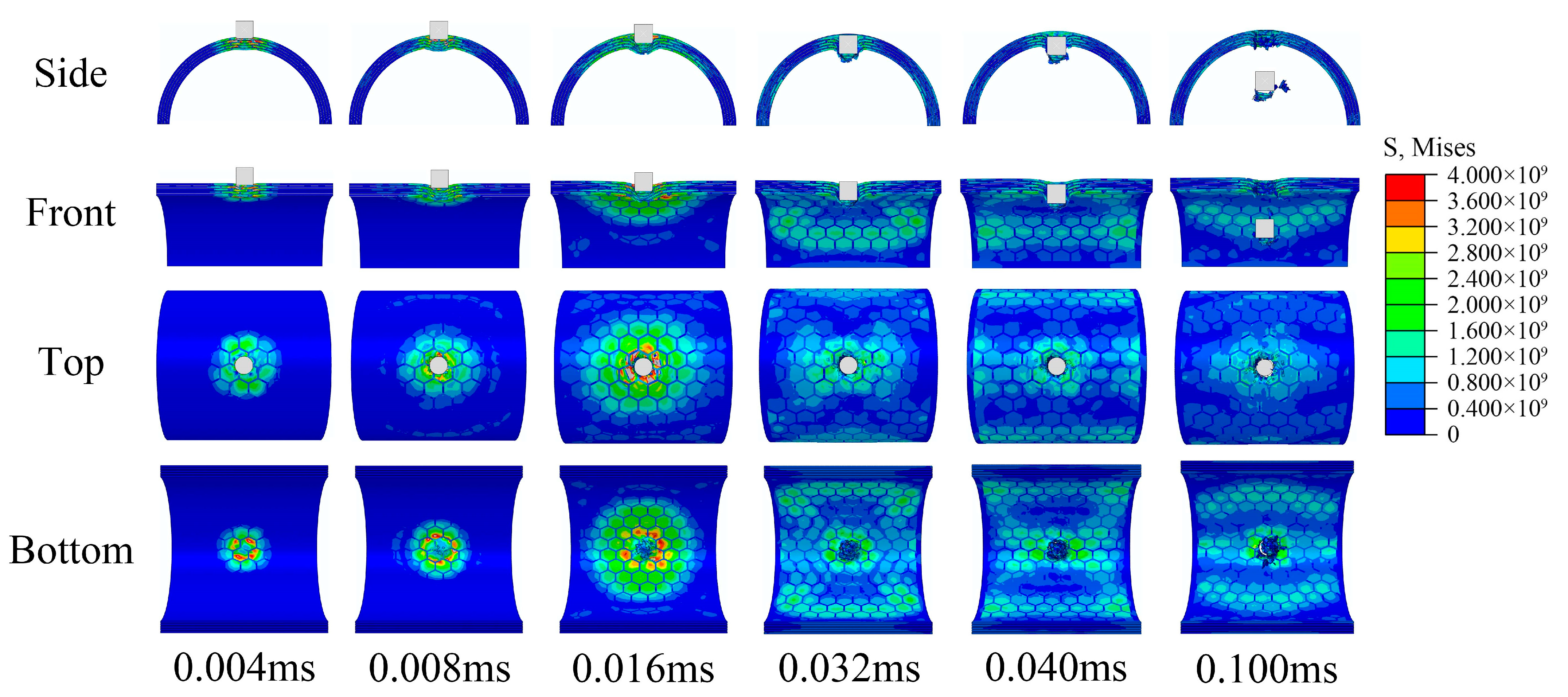

- Ceramic produce more morphological damage during resistance and absorb more impact energy of the bullet.
- The semi-cylindrical shell structure weakens the brittle fracture of the ceramic and enhances the overall resistance.
4.2. Energy Variation Analysis
5. Discussion of Impact Velocity
5.1. Damage Characteristics Analysis
5.2. Residual Velocity Analysis
5.3. Semi-Cylindrical Shell Top Displacement Analysis
6. Summary and Conclusions
- Based on the two-dimensional structure of the nacre, an elastic theoretical model of the two-phase distribution was established. The theoretical model was verified to be reliable and can be used to predict the equivalent elastic modulus of nacre-like composites.
- From the theoretical results and numerical models, increasing the elastic modulus of the tablets can enhance the equivalent elastic modulus of the nacre-like composite more effectively. When the elastic modulus of the slurry is greater than 20% of the tablets, and its volume fraction is less than 10%, the isotropic properties of the composite can be better achieved.
- The semi-cylindrical ceramic shell has the highest stiffness and ballistic limit, but the violent vibration generated after the impact causes penetrating cracks. The cracks eventually lead to the whole failure of the structure. The nacre-like composites have higher ballistic limit than aluminum shell. The bullet impact only causes local failure, and the structural integrity is better maintained. Semi-cylindrical aluminum shells have the lowest ballistic limit, it was damage by the shear of bullet’s edge and forms a large fragment only in front of the warhead.
- Under the same conditions, the regularly composites have less damage and lower bullet residual velocity than the irregularly composites, this indicates regular structure has better impact resistance performance.
- The semi-cylindrical shell vibrated under the bullet impact, and the vibration amplitude increased with the velocity of bullet impact. When the bullet impact velocity is high, the vibration of ceramic is more intense than nacre-like composite and aluminum.
Author Contributions
Funding
Institutional Review Board Statement
Informed Consent Statement
Data Availability Statement
Conflicts of Interest
Glossary
| Tensile stiffness | |
| Cross-sectional area | |
| Length | |
| Structure size | |
| Strain | |
| Equivalent elastic modulus | |
| Tensile stiffness of A, B elastomers | |
| Strain of A, B elastomers | |
| Young’s elastic modulus of A, B elastomers | |
| Fraction of volume occupied, | |
| Load | |
| Load of A, B elastomers | |
| Fraction of volume occupied, | |
| Elastic modulus of the series part | |
| Volume fraction of tablets in the layer, | |
| Elastic modulus of slurry | |
| Elastic modulus of tablets | |
| Volume fraction of the tablets in the composites, | |
| Volume fraction of the tablets | |
| Hydrostatic pressure | |
| the constant of Drucker-Prager model | |
| The pressure at the Hugoniot elastic limit (HEL) | |
| The equivalent stress at the HEL | |
| The strain at failure | |
| Material constants | |
| Ceramic density | |
| Volumetric strain | |
| Static yield stress | |
| Equivalent plastic strain | |
| Dimensionless temperature | |
| Current temperature | |
| Melting temperature | |
| Transition temperature | |
| Reference temperature | |
| Damage parameter | |
| Increment of the equivalent plastic strain | |
| Material parameters determined from different mechanical test | |
| Reference strain rate | |
| Inelastic heat fraction | |
| Bulk speed of sound | |
| Slope of the linear | |
| Proof/Yield stress | |
| Strain hardening coefficient | |
| Non-axial compressive yield stress | |
| Shear modulus | |
| Density | |
| Young’s modulus of elasticity | |
| Poisson’s ratio | |
| Specific heat | |
| Thermal softening constant | |
| Constants of best fit data points | |
| Ballistic limit; | |
| Impact velocity of bullet | |
| Residual velocity of bullet |
References
- Wu, X.D.; Meng, X.S.; Zhang, H.G. An experimental investigation of the dynamic fracture behavior of 3D printed nacre-like composites. J. Mech. Behav. Biomed. Mater. 2020, 112, 104068. [Google Scholar] [CrossRef]
- Song, F.; Soh, A.K.; Bai, Y.L. Structural and mechanical properties of the organic matrix layers of nacre. Biomaterials 2003, 24, 3623–3631. [Google Scholar] [CrossRef] [PubMed]
- Sun, J.Y.; Bhushan, B. Hierarchical structure and mechanical properties of nacre: A review. Rsc. Adv. 2012, 2, 7617–7632. [Google Scholar] [CrossRef]
- Barthelat, F.; Rim, J.E.; Espinosa, H.D. A Review on the Structure and Mechanical Properties of Mollusk Shells—Perspectives on Synthetic Biomimetic Materials. In Applied Scanning Probe Methods XIII; Springer: Berlin, Germany, 2009; pp. 17–44. [Google Scholar] [CrossRef]
- Miao, T.Y.; Shen, L.M.; Xu, Q.F.; Flores-Johnson, E.A.; Zhang, J.J.; Lu, G.X. Ballistic performance of bioinspired nacre-like aluminium composite plates. Compos. Part B-Eng. 2019, 177, 107382. [Google Scholar] [CrossRef]
- Humburg, H.; Zhu, D.J.; Beznia, S.; Barthelat, F. Bio-inspired tapered fibers for composites with superior toughness. Compos. Sci. Technol. 2012, 72, 1012–1019. [Google Scholar] [CrossRef]
- Yao, H.M.; Song, Z.G.; Xu, Z.P.; Gao, H.J. Cracks fail to intensify stress in nacreous composites. Compos. Sci. Technol. 2013, 81, 24–29. [Google Scholar] [CrossRef]
- Currey, J.D. Mechanical Properties of Mother of Pearl in Tension. Proc. R. Soc. Lond. Ser. B Biol. Sci. 1977, 196, 443–463. [Google Scholar] [CrossRef]
- Barthelat, F.; Dastjerdi, A.K.; Rabiei, R. An improved failure criterion for biological and engineered staggered composites. J. R. Soc. Interface 2013, 10, 20120849. [Google Scholar] [CrossRef]
- Rousseau, M.; Lopez, E.; Stempfle, P.; Brendle, M.; Franke, L.; Guette, A.; Naslain, R.; Bourrat, X. Multiscale structure of sheet nacre. Biomaterials 2005, 26, 6254–6262. [Google Scholar] [CrossRef]
- Maghsoudi-Ganjeh, M.; Lin, L.Q.; Yang, X.Z.; Zeng, X.W. Computational modeling and simulation of bioinspired nacre-like composites. J. Mater. Res. 2021, 36, 2651–2661. [Google Scholar] [CrossRef]
- Cui, Z.S.; Zhang, M.H.; Wang, Y.T.; Chen, Y.; Hu, R.Q.; Zhang, C. Failure progression and toughening mechanism of 3D-printed nacre-like structures under in-plane compression. J. Mech. Behav. Biomed. Mater. 2023, 138, 105653. [Google Scholar] [CrossRef]
- Li, T.; Ma, B.; Xue, J.M.; Zhai, D.; Zhao, P.Y.; Chang, J.; Wu, C.T. Bioinspired Biomaterials with a Brick-and-Mortar Microstructure Combining Mechanical and Biological Performance. Adv. Healthc. Mater. 2020, 9, 1901211. [Google Scholar] [CrossRef] [PubMed]
- Woo, J.Y.; Oh, J.H.; Jo, S.; Han, C.S. Nacre-Mimetic Graphene Oxide/Cross-Linking Agent Composite Films with Superior Mechanical Properties. ACS Nano 2019, 13, 4522–4529. [Google Scholar] [CrossRef]
- Zhang, W.; Xu, J.; Yu, T. Dynamic behaviors of bio-inspired structures: Design, mechanisms, and models. Eng. Struct. 2022, 265, 114490. [Google Scholar] [CrossRef]
- Wang, R.Z.; Suo, Z.; Evans, A.G.; Yao, N.; Aksay, I.A. Deformation mechanisms in nacre. Mater. Res. Soc. 2001, 16, 2485–2493. [Google Scholar] [CrossRef]
- Khan, N.S.; Shah, Q.; Sohail, A.; Ullah, Z.; Kaewkhao, A.; Kumam, P.; Zubair, S.; Ullah, N.; Thounthong, P. Rotating flow assessment of magnetized mixture fluid suspended with hybrid nanoparticles and chemical reactions of species. Sci. Rep. 2021, 11, 11277. [Google Scholar] [CrossRef]
- Khan, N.S.; Shah, Q.Y.; Sohail, A.; Kumam, P.; Thounthong, P.; Muhammad, T. Mechanical aspects of Maxwell nanofluid in dynamic system with irreversible analysis. Zamm-Z. Angew. Math. Mech. 2021, 101, e202000212. [Google Scholar] [CrossRef]
- Barthelat, F.; Tang, H.; Zavattieri, P.D.; Li, C.M.; Espinosa, H.D. On the mechanics of mother-of-pearl: A key feature in the material hierarchical structure. J. Mech. Phys. Solids 2007, 55, 306–337. [Google Scholar] [CrossRef]
- Wang, Z.G.; Sun, Y.Y.; Wu, H.; Zhang, C.W. Low velocity impact resistance of bio-inspired building ceramic composites with nacre-like structure. Constr. Build. Mater. 2018, 169, 851–858. [Google Scholar] [CrossRef]
- Ko, K.; Jin, S.; Lee, S.E.; Hong, J.W. Impact resistance of nacre-like composites diversely patterned by 3D printing. Compos. Struct. 2020, 238, 111951. [Google Scholar] [CrossRef]
- Ghazlan, A.; Ngo, T.; Le, T.V.; Nguyen, T.; Remennikov, A. Blast performance of a bio-mimetic panel based on the structure of nacre—A numerical study. Compos. Struct. 2020, 234, 111691. [Google Scholar] [CrossRef]
- Wei, Z.Q.; Xu, X.H. Gradient design of bio-inspired nacre-like composites for improved impact resistance. Compos. Part B Eng. 2021, 215, 108830. [Google Scholar] [CrossRef]
- Ko, K.; Lee, S.; Hwang, Y.K.; Jin, S.; Hong, J.W. Investigation on the impact resistance of 3D printed nacre-like composites. Thin-Walled Struct. 2022, 177, 109392. [Google Scholar] [CrossRef]
- Wu, K.J.; Song, Y.H.; Zhang, X.; Zhang, S.S.; Zheng, Z.J.; Gong, X.L.; He, L.H.; Yao, H.B.; Ni, Y. A Prestressing Strategy Enabled Synergistic Energy-Dissipation in Impact-Resistant Nacre-Like Structures. Adv. Sci. 2022, 9, 2104867. [Google Scholar] [CrossRef] [PubMed]
- Xiao, Y.H.; Tang, Z.Q.; Hong, X.F. Low velocity impact resistance of ceramic/polyurea composite plates: Experimental study. J. Mech. Sci. Technol. 2021, 35, 5425–5434. [Google Scholar] [CrossRef]
- Flores-Johnson, E.A.; Shen, L.M.; Guiamatsia, I.; Nguyen, G.D. Numerical investigation of the impact behaviour of bioinspired nacre-like aluminium composite plates. Compos. Sci. Technol. 2014, 96, 13–22. [Google Scholar] [CrossRef]
- Grujicic, M.; Snipes, J.S.; Ramaswami, S. Ballistic Impact Behavior of Nacre-Like Laminated Composites Consisting of B4C Tablets and Polyurea Matrix. J. Mater. Eng. Perform. 2016, 25, 977–994. [Google Scholar] [CrossRef]
- Tan, G.Q.; Yu, Q.; Liu, Z.Q.; Wang, X.G.; Zhang, M.Y.; Liu, Y.Y.; Zhang, Z.F.; Ritchie, R.O. Compression fatigue properties and damage mechanisms of a bioinspired nacre-like ceramic-polymer composite. Scr. Mater. 2021, 203, 114089. [Google Scholar] [CrossRef]
- Magrini, T.; Senol, A.; Style, R.; Bouville, F.; Studart, A.R. Fracture of hierarchical multi-layered bioinspired composites. J. Mech. Phys. Solids 2022, 159, 104750. [Google Scholar] [CrossRef]
- Wang, R.Z.; Wen, H.B.; Cui, F.Z.; Zhang, H.B.; Li, H.D. Observations of damage morphologies in nacre during deformation and fracture. J. Mater. Sci. 1995, 30, 2299–2304. [Google Scholar] [CrossRef]
- Li, X.D.; Xu, Z.H.; Wang, R.Z. In situ observation of nanograin rotation and deformation in nacre. Nano Lett. 2006, 6, 2301–2304. [Google Scholar] [CrossRef] [PubMed]
- Zhou, L.C.; Zhu, Y.B.; He, Z.Z.; Jin, X.; Wu, H.A. Multi-parameter structural optimization to reconcile mechanical conflicts in nacre-like composites. Compos. Struct. 2021, 259, 113225. [Google Scholar] [CrossRef]
- Dutta, A.; Tekalur, S.A. Crack tortuousity in the nacreous layer—Topological dependence and biomimetic design guideline. Int. J. Solids Struct. 2014, 51, 325–335. [Google Scholar] [CrossRef]
- Greco, F.; Leonetti, L.; De Maio, U.; Rudykh, S.; Pranno, A. Macro- and micro-instabilities in incompressible bioinspired composite materials with nacre-like microstructure. Compos. Struct. 2021, 269, 114004. [Google Scholar] [CrossRef]
- Soe, S.; Adams, R.; Hossain, M.; Theobald, P. Investigating the dynamic compression response of elastomeric, additively manufactured fluid-filled structures via experimental and finite element analyses. Addit. Manuf. 2021, 39, 101885. [Google Scholar] [CrossRef]
- Lee, S.; Lim, D.D.; Pegg, E.; Gu, G.X. The origin of high-velocity impact response and damage mechanisms for bioinspired composites. Cell Rep. Phys. Sci. 2022, 3, 101152. [Google Scholar] [CrossRef]
- Garzon-Hernandez, S.; Garcia-Gonzalez, D.; Arias, A. Multi-impact mechanical behaviour of short fibre reinforced composites. Compos. Struct. 2018, 202, 241–252. [Google Scholar] [CrossRef]
- Zhu, H.; Li, D.S.; Jiang, L.; Fang, D.N. An experimental and numerical investigation of the ballistic penetration behavior and failure mechanism of 3D MWK composites. Compos. Struct. 2022, 299, 116041. [Google Scholar] [CrossRef]
- Dongyang Gao, P.C.; Lu, G.; Yang, H. Numerical analysis for impact resistance of nacre-like composites. Mater. Today Commun. 2023, 35, 106031. [Google Scholar]
- Zhao, Y.F.; Wu, F.; Zhao, Y.; Sui, C.; Wang, C.; Tan, H.F. The effect of binders on the compressive mechanical behavior and impact resistance of graphene self-assembled ball. Comput. Mater. Sci. 2022, 213, 111674. [Google Scholar] [CrossRef]
- Hibbeler, R.C. Mechanics of Materials; ChongQing University Press: Chongqing, China, 2007. [Google Scholar]
- Jackson, A.P.; Vincent, J.F.V.; Turner, R.M. The mechanical design of nacre. Proc. R. Soc. Lond. B Biol. Sci. 1988, 234, 415–440. [Google Scholar]
- Katti, K.S.; Katti, D.R. Why is nacre so tough and strong? Mater. Sci. Eng. C 2006, 26, 1317–1324. [Google Scholar] [CrossRef]
- Tran, P.; Ngo, T.D.; Ghazlan, A.; Hui, D. Bimaterial 3D printing and numerical analysis of bio-inspired composite structures under in-plane and transverse loadings. Compos. Part B-Eng. 2017, 108, 210–223. [Google Scholar] [CrossRef]
- Su, Z.Y.; Yang, X.; Liu, G.J.; Li, W.Q.; Tang, W.Q. Topology authentication for piping isometric drawings. Comput.-Aided Des. 2015, 66, 33–44. [Google Scholar] [CrossRef]
- Iza-Teran, R.; Garcke, J. A Geometrical Method for Low-Dimensional Representations of Simulations. SIAM/ASA J. Uncertain. Quantif. 2019, 7, 472–496. [Google Scholar] [CrossRef]
- Feng, S.; Krim, H.; Kogan, I.A. 3D face recognition using Euclidean integral invariants signature. In Proceedings of the 14th IEEE/SP Workshop on Statistical Signal Processing, Madison, WI, USA, 26–29 August 2007; p. 156. [Google Scholar]
- Hibbitt, H.; Karlsson, B.; Sorensen, P. Abaqus Analysis User’s Manual Version 6.10; SIMULIA: Johnston, RI, USA, 2011. [Google Scholar]
- Holmquist, T.J.; Johnson, G.R. Characterization and evaluation of silicon carbide for high-velocity impact. J. Appl. Phys. 2005, 97, 093502. [Google Scholar] [CrossRef]
- Johnson, G.R.; Holmquist, T.J. An Improved Computational Constitutive Model for Brittle Materials. High Press. Sci. Technol. 1993, 309, 981–984. [Google Scholar]
- SIMULIA. Abaqus Analysis User’s Manual (Version 6.14); SIMULIA: Johnston, RI, USA, 2014. [Google Scholar]
- Johnson, G.R.; Cook, W.H. A constitutive model and data for metals subjected to large strains, high strain rates and high temperatures. In Proceedings of the 7th International Symposium on Ballistics, The Hague, The Netherlands, 21 April 1983; pp. 541–547. [Google Scholar]
- Johnson, G.R.; Cook, W.H. Fracture characteristics of three metals subjected to various strains, strain rates, temperatures and pressures. Eng. Fract. Mech. 1985, 21, 31–48. [Google Scholar] [CrossRef]
- Pottier, T.; Toussaint, F.; Louche, H.; Vacher, P. Inelastic heat fraction estimation from two successive mechanical and thermal analyses and full-field measurements. Eur. J. Mech. A/Solids 2013, 38, 1–11. [Google Scholar] [CrossRef]
- Mohotti, D.; Ali, M.; Ngo, T.; Lu, J.H.; Mendis, P.; Ruan, D. Out-of-plane impact resistance of aluminium plates subjected to low velocity impacts. Mater. Des. 2013, 50, 413–426. [Google Scholar] [CrossRef]
- Ghazlan, A.; Ngo, T.D.; Tran, P. Three-dimensional Voronoi model of a nacre-mimetic composite structure under impulsive loading. Compos. Struct. 2016, 153, 278–296. [Google Scholar] [CrossRef]
- Borvik, T.; Forrestal, M.J.; Warren, T.L. Perforation of 5083-H116 Aluminum Armor Plates with Ogive-Nose Rods and 7.62 mm APM2 Bullets. Exp. Mech. 2010, 50, 969–978. [Google Scholar] [CrossRef]
- Recht, R.F.; Ipson, T.W. Ballistic Perforation Dynamics. J. Appl. Mech. 1963, 30, 384–390. [Google Scholar] [CrossRef]
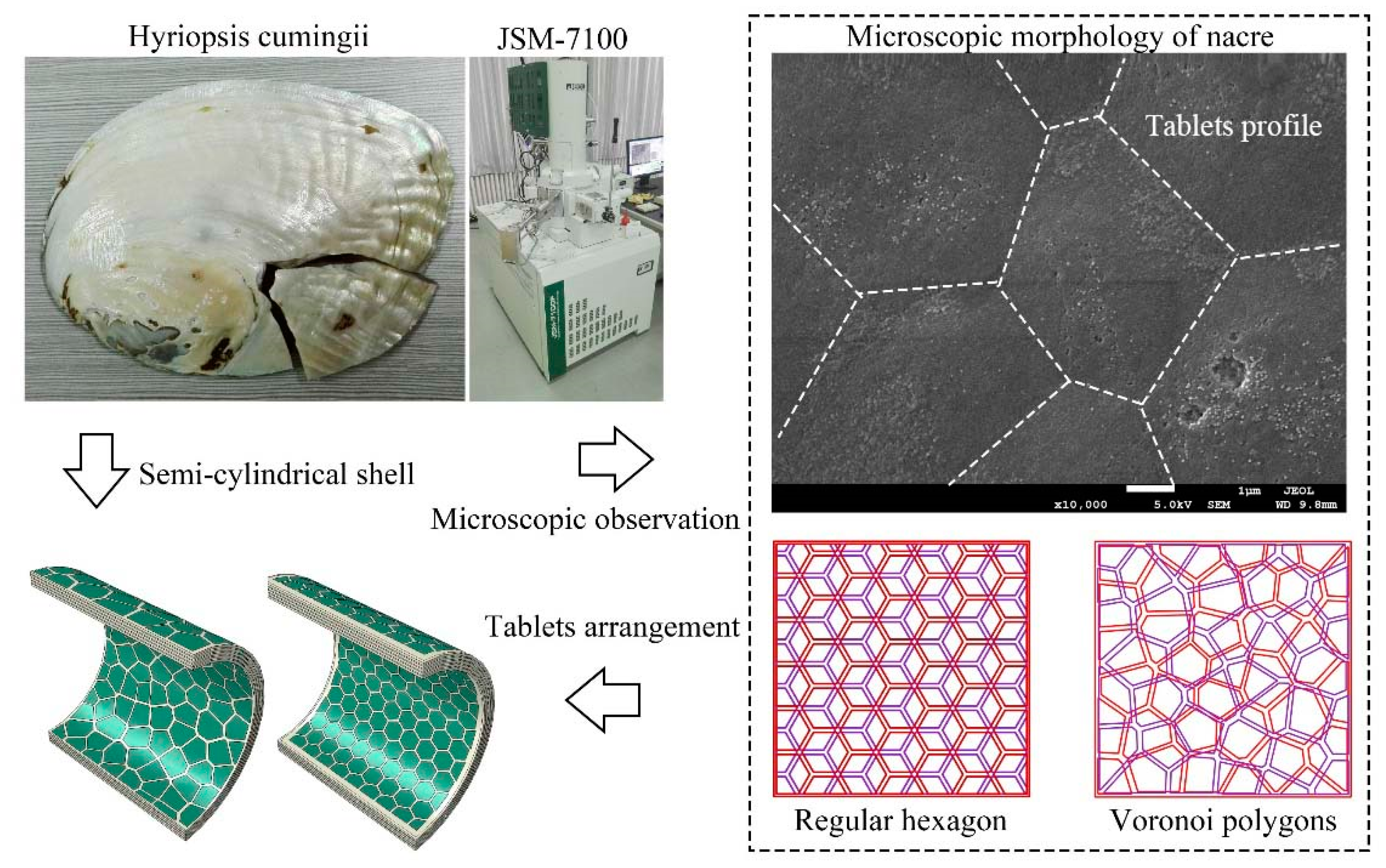

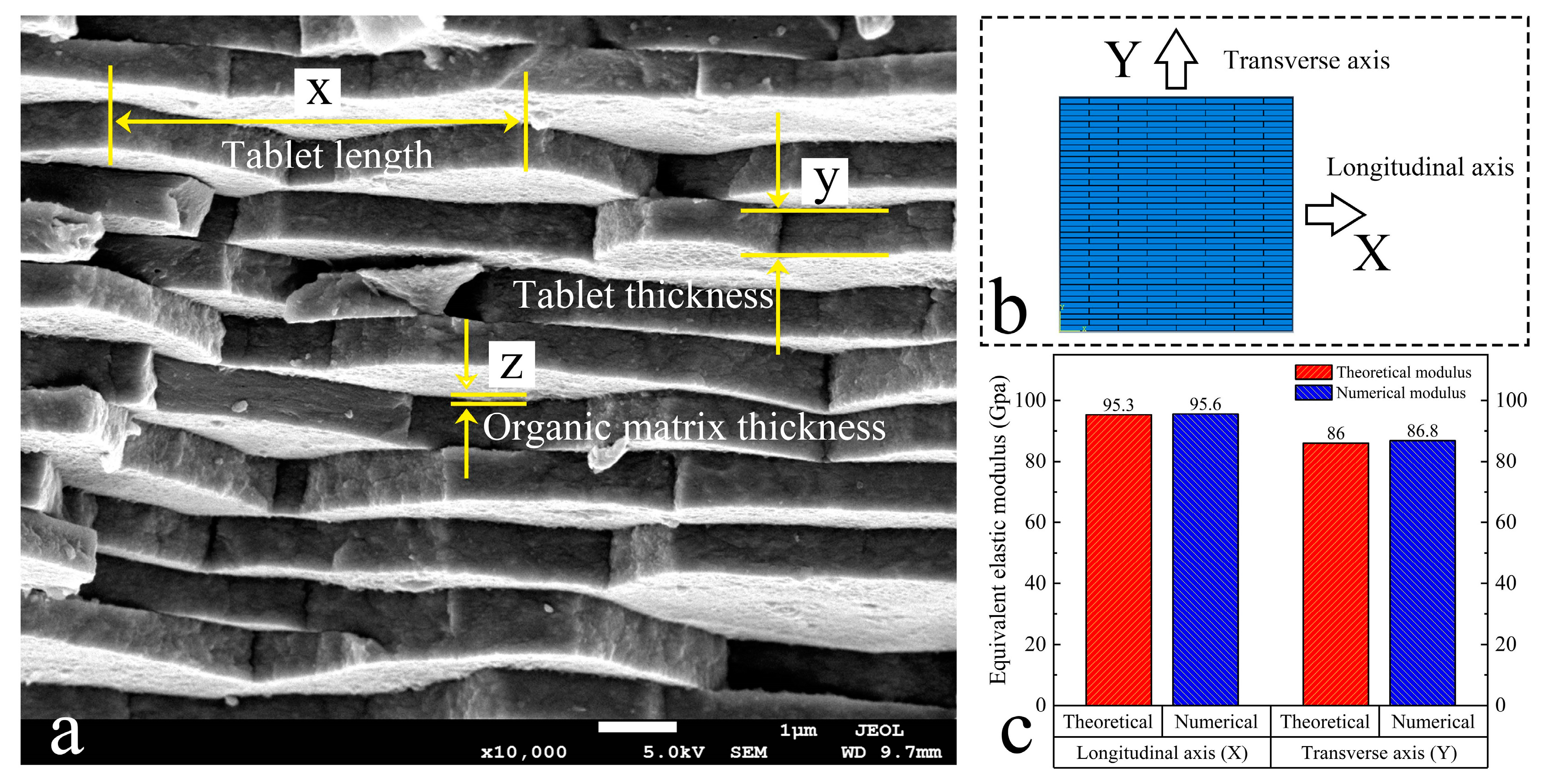
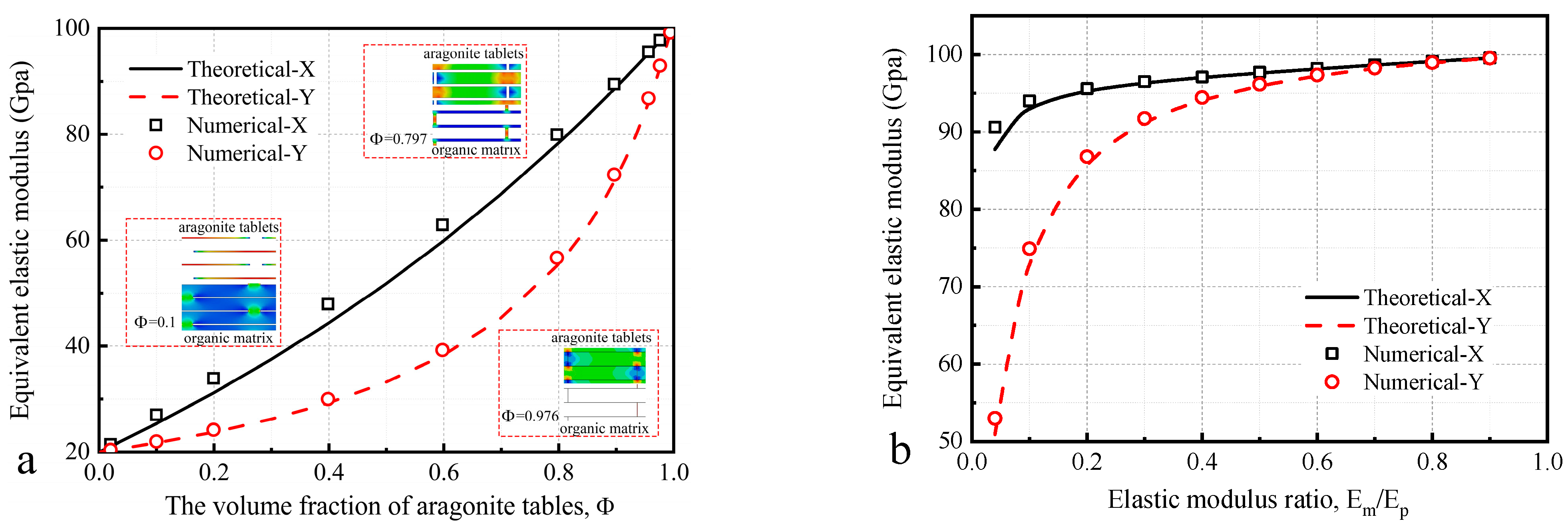
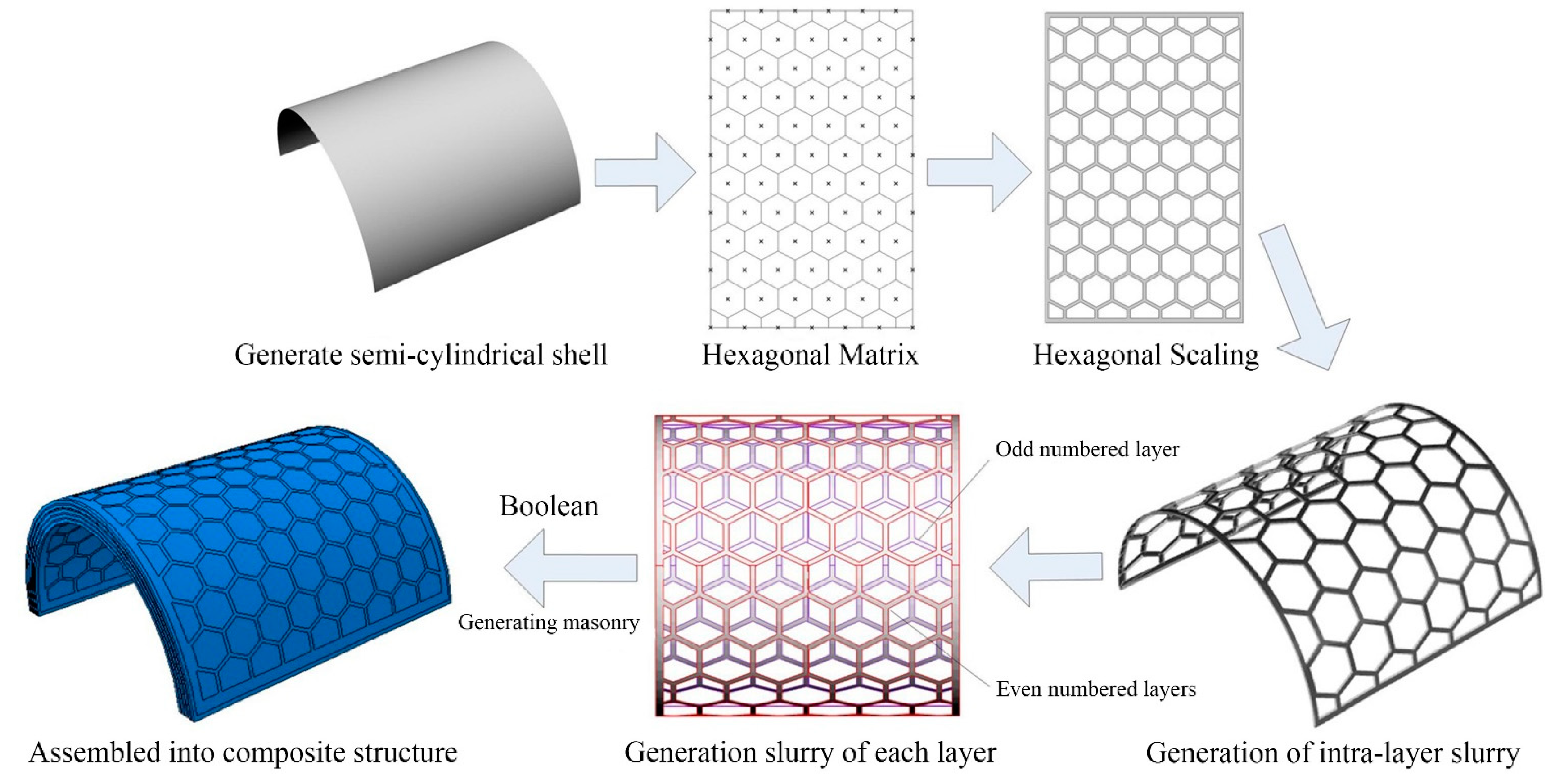
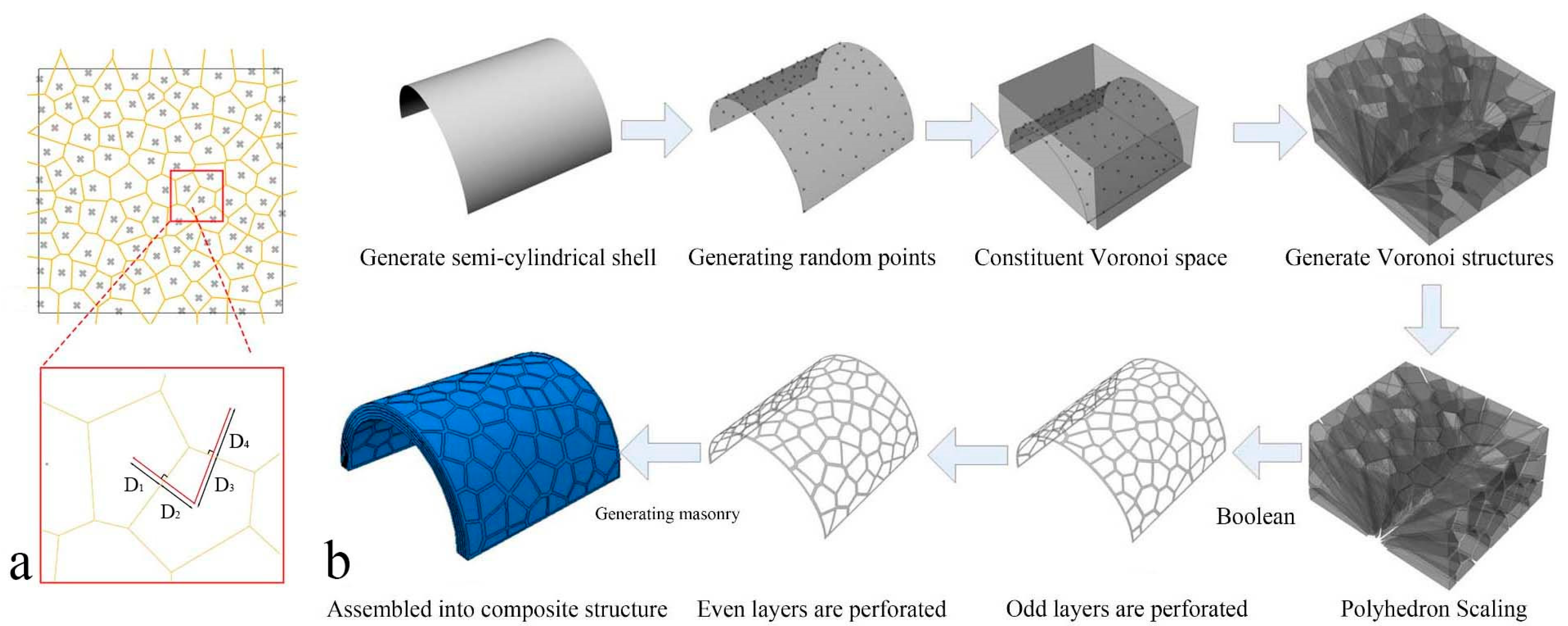
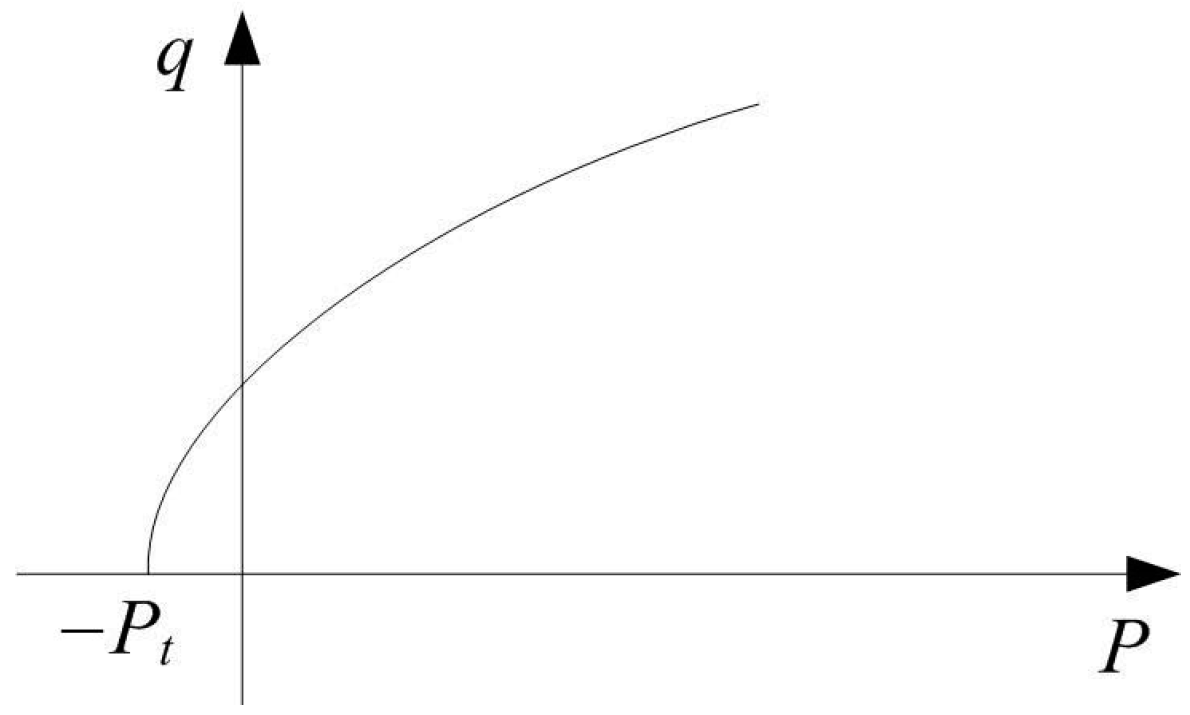
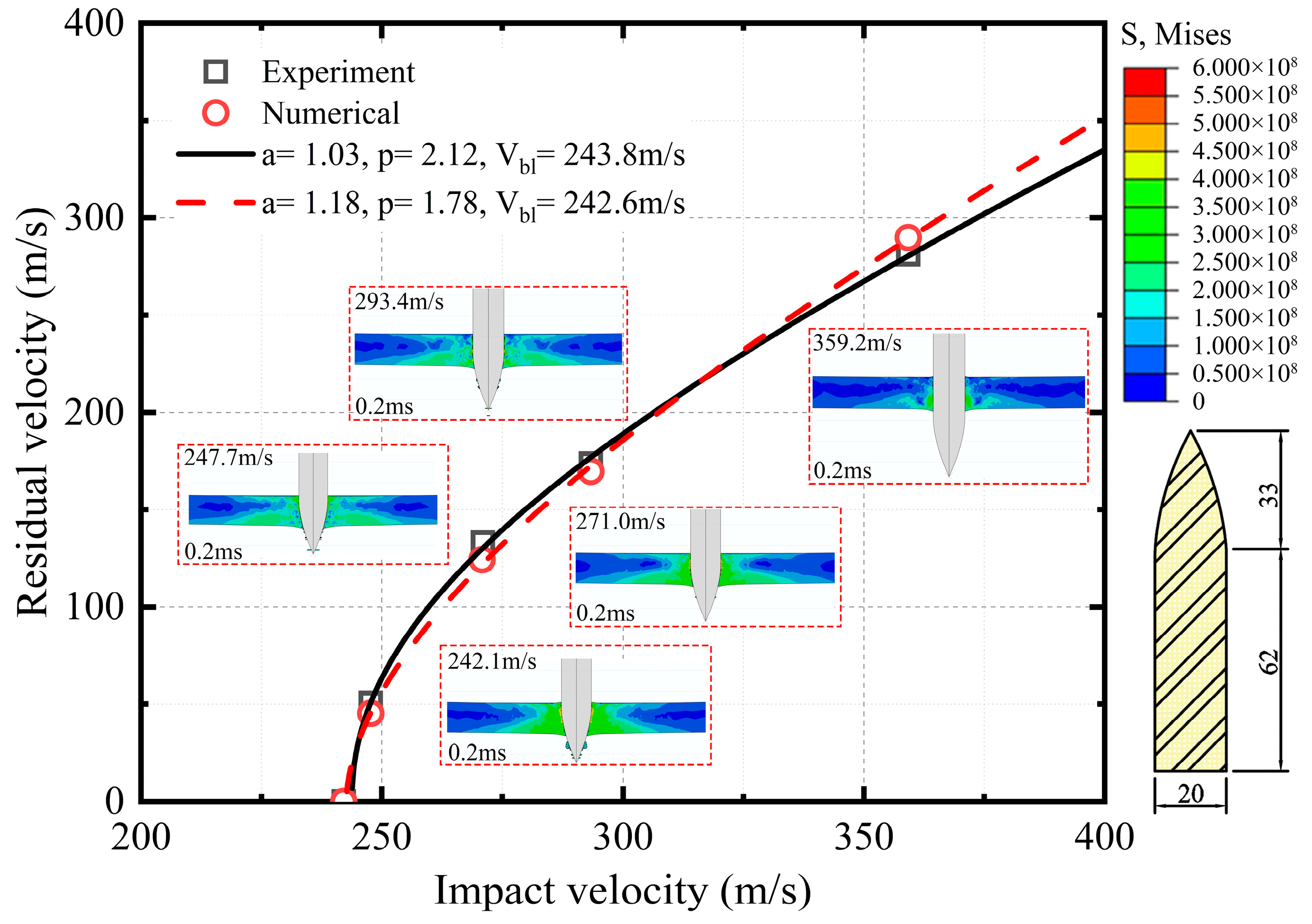
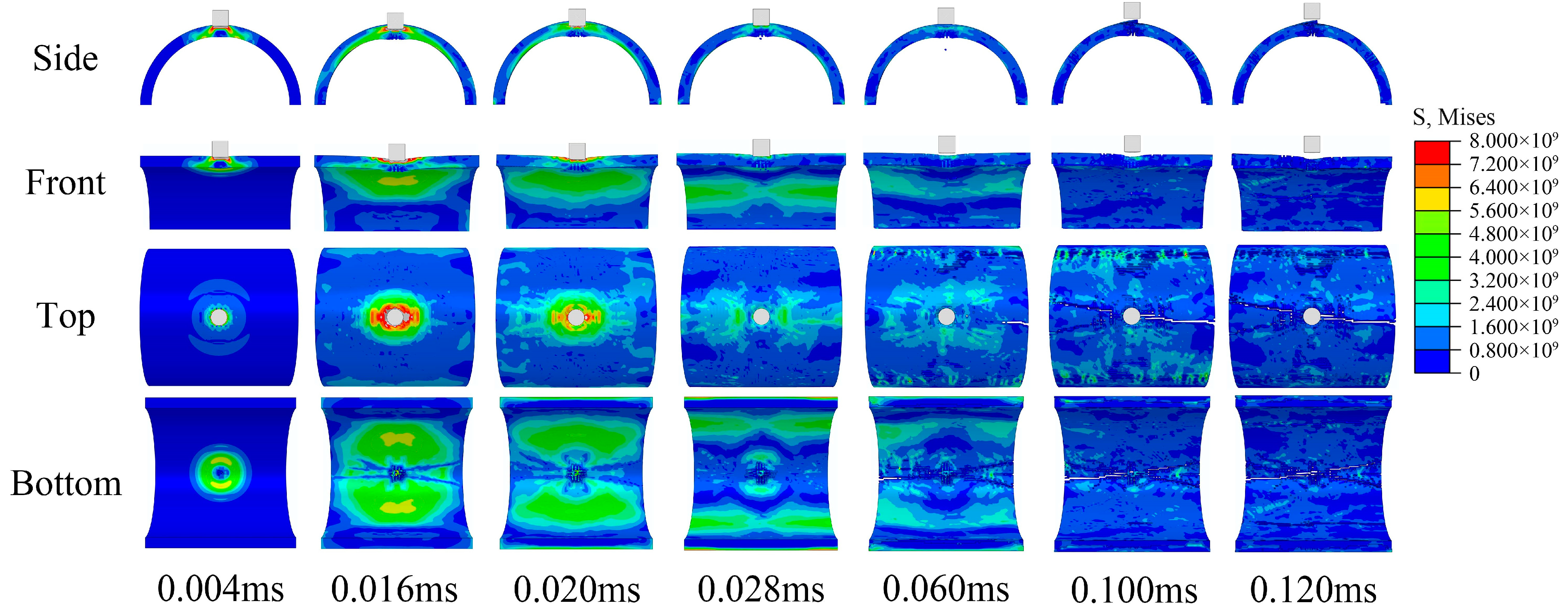
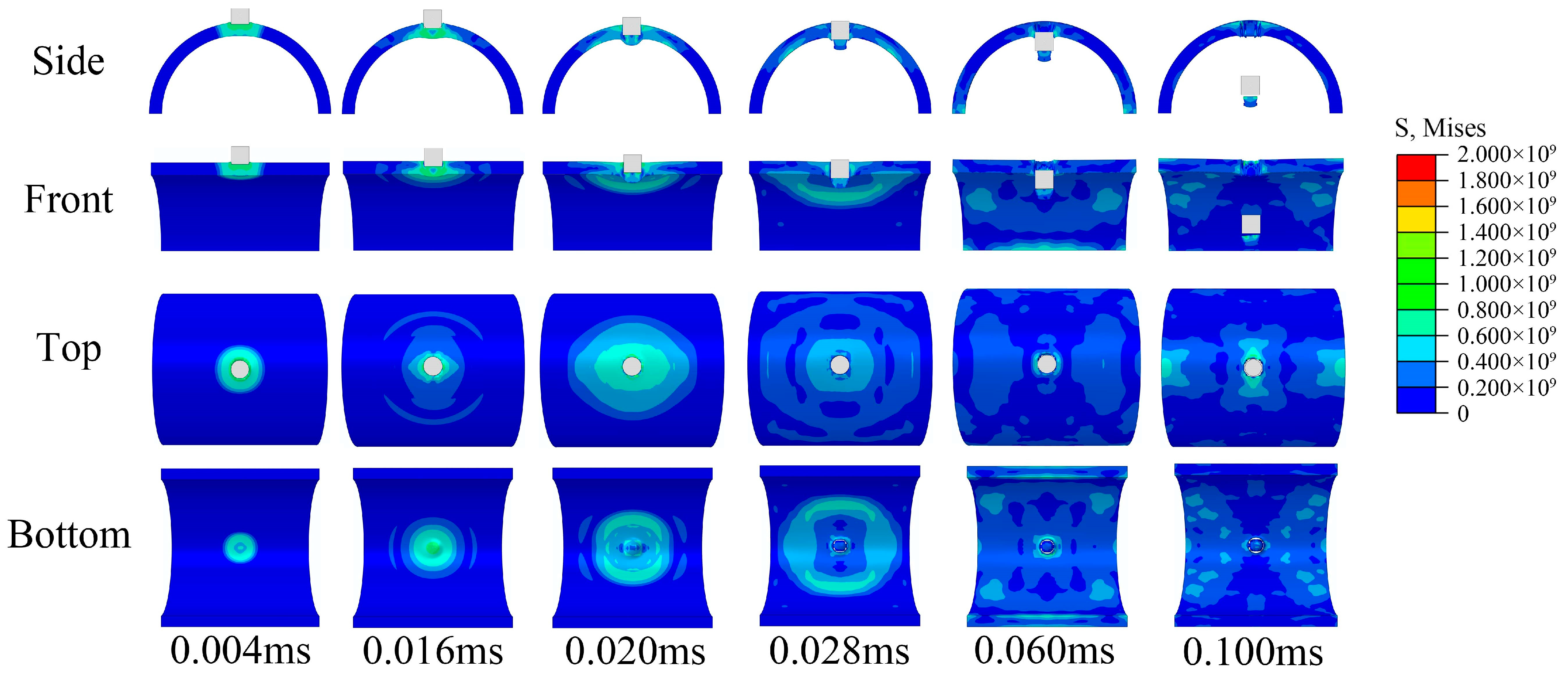
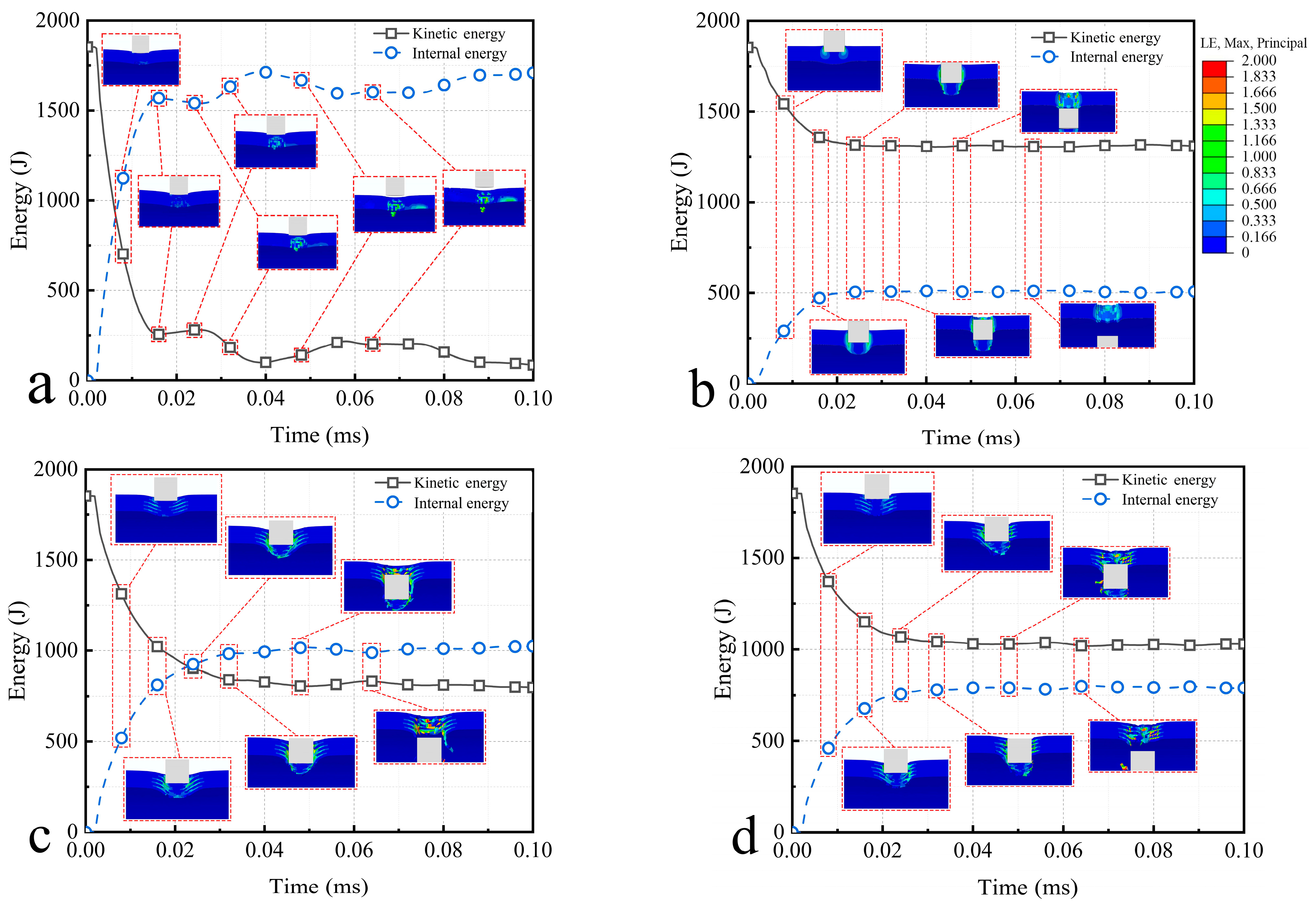
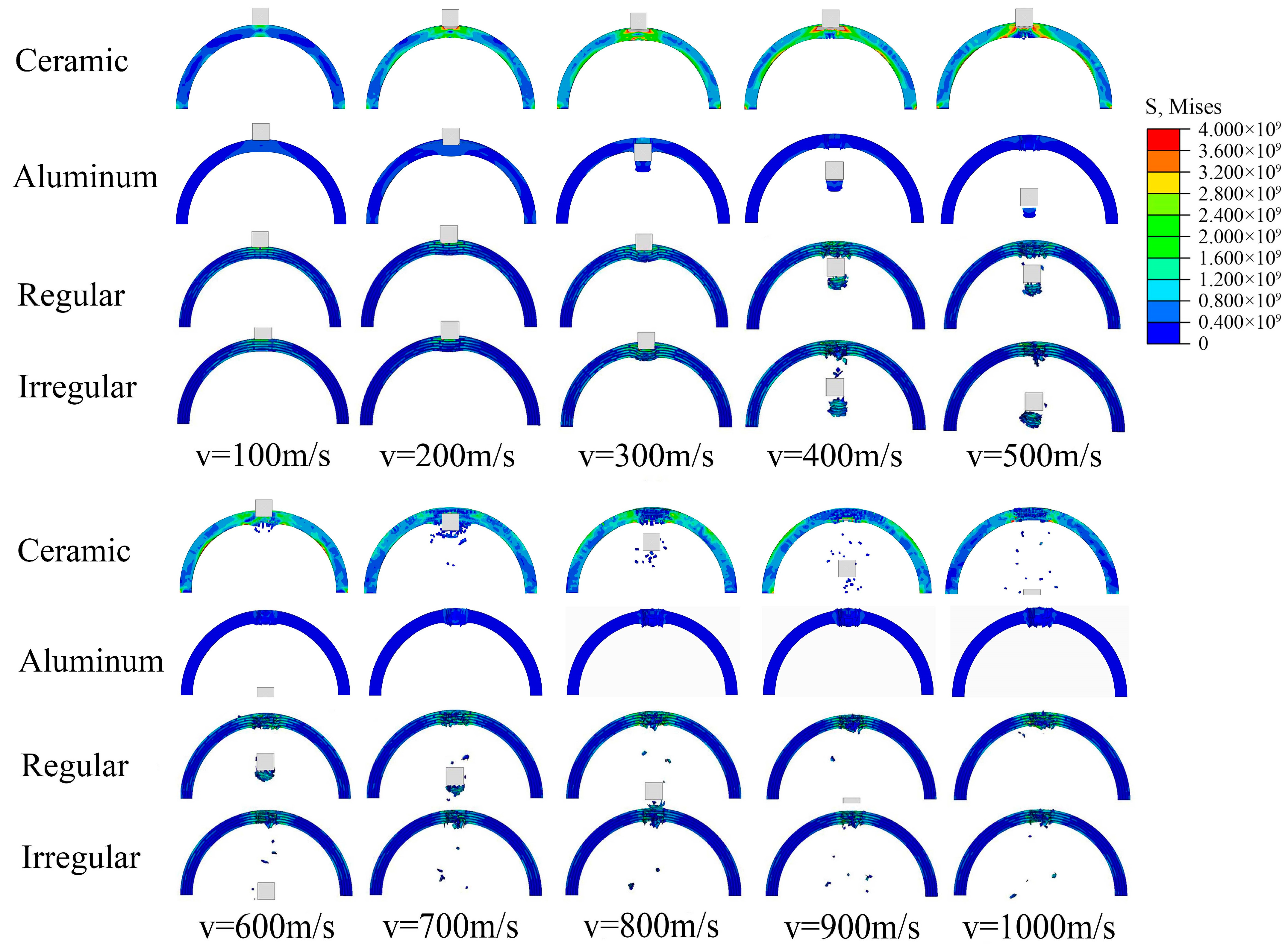
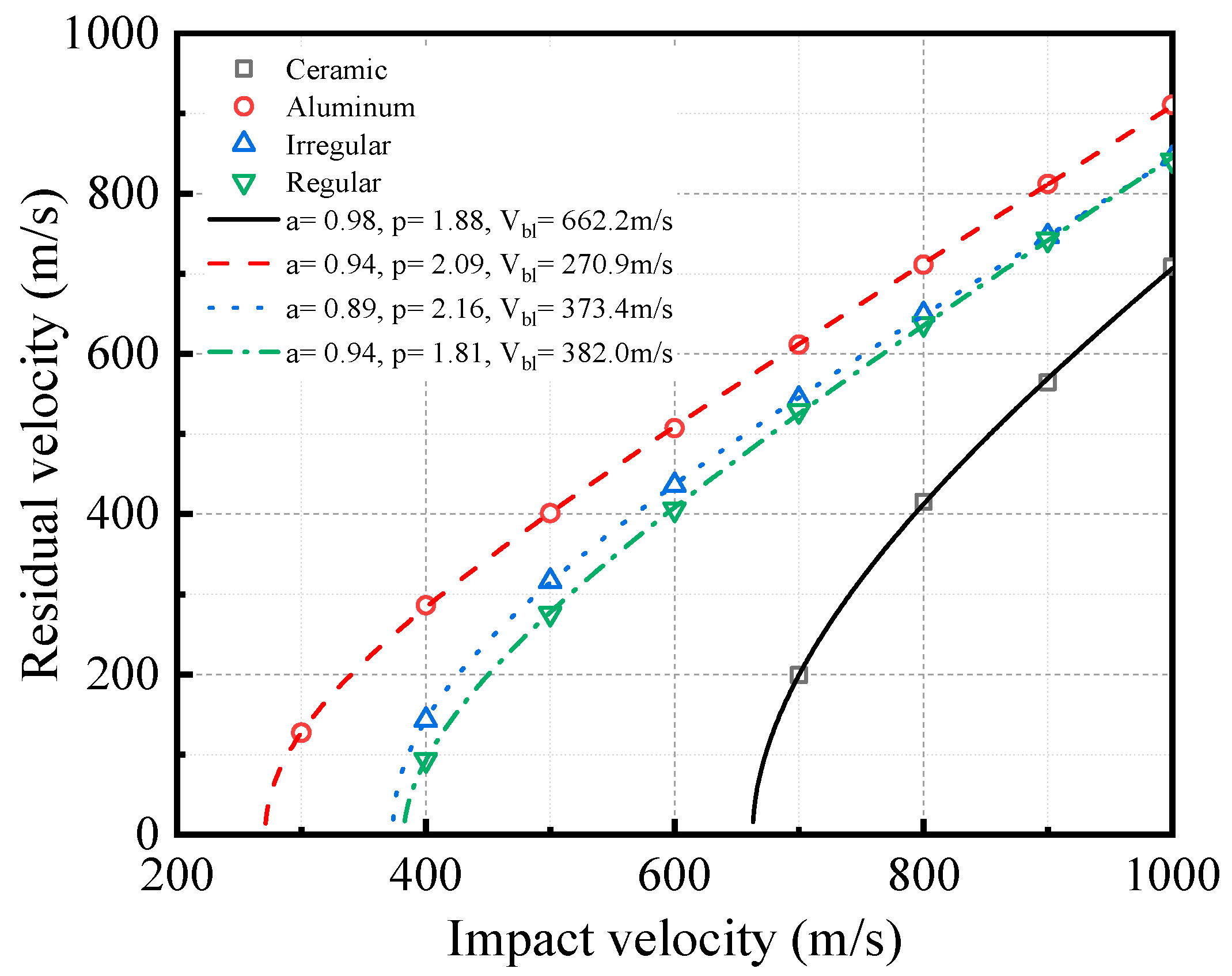


| Material Properties | Value |
|---|---|
| Density (kg/m3) | 3215 |
| shear modulus, (Gpa) | 193 |
| Drucker-Prager plastic model | |
| The constant of Drucker-Prager model, | 0.00392 |
| The constant of Drucker-Prager model, | 1.5384 |
| Hardening parameters of static water pressure, (Gpa) | 0.75 |
| Non-axial compressive yield stress, (Mpa) | 6605.66 |
| Johson-cook rate-related models | |
| Reference strain rate, (s−1) | 1 |
| Strain hardening coefficient, | 0.009 |
| Mie-Grüneisen state equation | |
| Bulk speed of sound, (m/s) | 8272.2 |
| Slope of the linear, | 1.32 |
| Equivalent Plastic Strain, | Stress Triaxiality |
|---|---|
| 0.0000757409 | 14.9582 |
| 0.000387262 | 5.81024 |
| 0.0010059 | 3.31439 |
| 0.00198007 | 2.20507 |
| 0.00334828 | 1.59126 |
| 0.00514314 | 1.20551 |
| 0.00739319 | 0.941806 |
| 0.0101241 | 0.75036 |
| 0.0133591 | 0.604923 |
| 0.0171197 | 0.490442 |
| 0.087533 | −0.0269666 |
| 0.227363 | −0.235092 |
| 0.447555 | −0.373262 |
| 0.756814 | −0.483609 |
| 1.16251 | −0.579447 |
| 1.67109 | −0.666391 |
| 2.28835 | −0.74727 |
| 3.01956 | −0.823696 |
| 3.86958 | −0.896673 |
| Material Properties | Value |
|---|---|
| Density (kg/m3) | 2750 |
| Young’s modulus of elasticity, (Gpa) | 70 |
| Poisson’s ratio, | 0.3 |
| Inelastic heat fraction, | 0.9 |
| Specific heat, (J/kgK) | 910 |
| Proof/Yield stress, (Mpa) | 215 |
| Strain hardening coefficient, (Mpa) | 280 |
| Strain hardening coefficient, | 0.404 |
| Strain hardening coefficient, | 0.0085 |
| Thermal softening constant, | 0.859 |
| Reference strain rate, (s−1) | 0.001 |
| Reference temperature, (K) | 293 |
| Melting temperature (K) | 893 |
| 0.096 | |
| 0.049 | |
| 3.465 | |
| 0.016 | |
| 1.099 |
Disclaimer/Publisher’s Note: The statements, opinions and data contained in all publications are solely those of the individual author(s) and contributor(s) and not of MDPI and/or the editor(s). MDPI and/or the editor(s) disclaim responsibility for any injury to people or property resulting from any ideas, methods, instructions or products referred to in the content. |
© 2023 by the authors. Licensee MDPI, Basel, Switzerland. This article is an open access article distributed under the terms and conditions of the Creative Commons Attribution (CC BY) license (https://creativecommons.org/licenses/by/4.0/).
Share and Cite
Yang, H.; Gao, D.; Chen, P.; Lu, G. Numerical Investigation on the Ballistic Performance of Semi-Cylindrical Nacre-like Composite Shells under High-Velocity Impact. Materials 2023, 16, 3699. https://doi.org/10.3390/ma16103699
Yang H, Gao D, Chen P, Lu G. Numerical Investigation on the Ballistic Performance of Semi-Cylindrical Nacre-like Composite Shells under High-Velocity Impact. Materials. 2023; 16(10):3699. https://doi.org/10.3390/ma16103699
Chicago/Turabian StyleYang, Huiwei, Dongyang Gao, Pengcheng Chen, and Guoyun Lu. 2023. "Numerical Investigation on the Ballistic Performance of Semi-Cylindrical Nacre-like Composite Shells under High-Velocity Impact" Materials 16, no. 10: 3699. https://doi.org/10.3390/ma16103699






